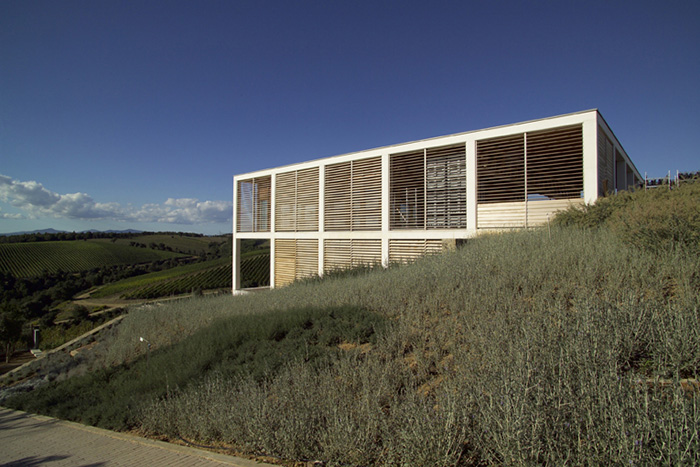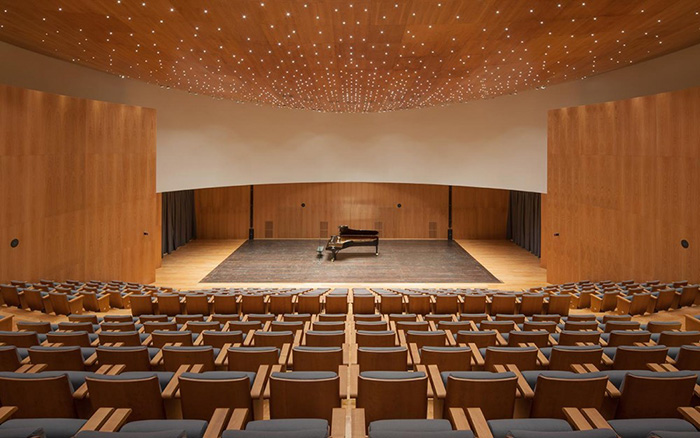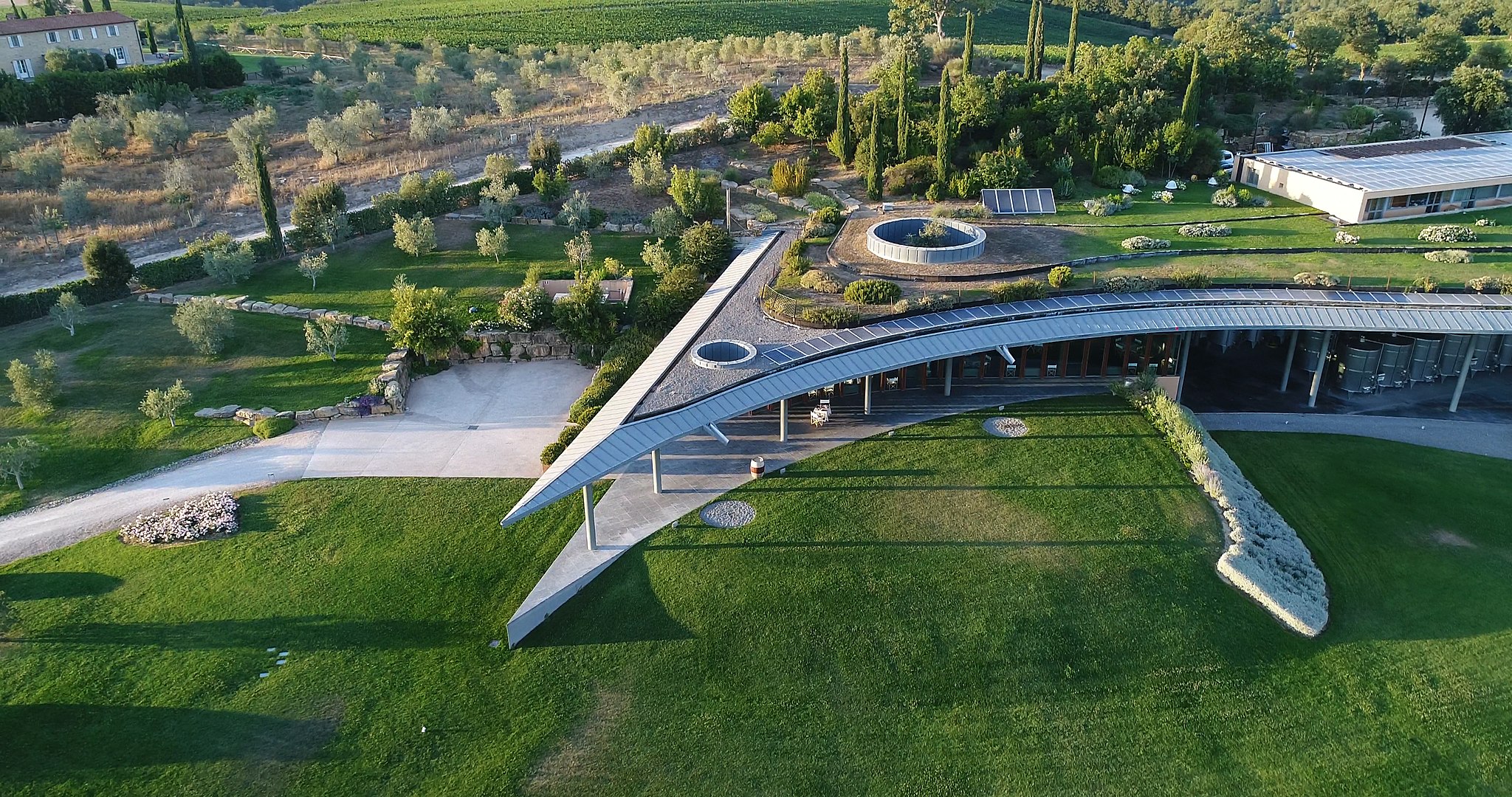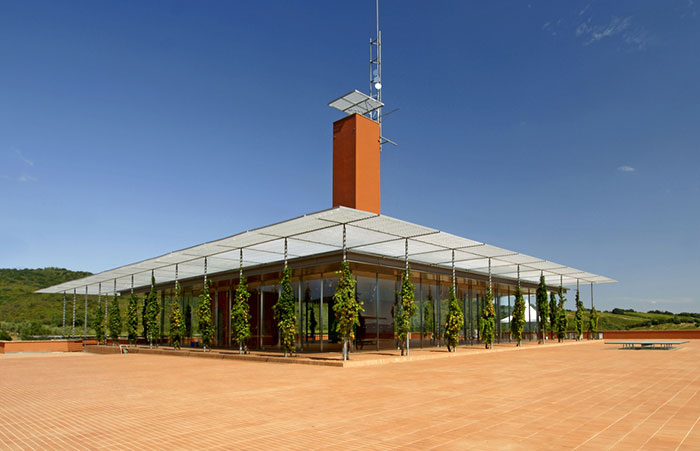| |
|
Monte Amiata and Maremma
|
Cantina ColleMassari
Castello ColleMassari wine estate lies on the slopes of Monte Amiata, 320 metres above sea level, enjoying perfect conditions for growing Sangiovese. The wine estate adheres to organic guidelines guaranteed and certified by ICEA.
The Collemassari winery is situated in Cinigiano, near Poggi del Sasso. Designed by Edoardo Milesi.
In 2015 Edward Milesi & Archos also designed Forum Fondazione Bertarelli, a music hall and auditorium, located in Poggi del Sasso, Cinigiano.
Castello ColleMassari
Località Poggi del Sasso, Cinigiano
Phone: 0564 990496
E-mail:info@collemassari.it
Website: http://www.collemassari.it
|
 |
Cantina ColleMassari. Photographer : Paolo Da Re
|
| Castello ColleMassari | La Cantina
The building is a wooden box. The warehouse, the plant rooms, the barn for farm equipment have been built inside the hill. The only element that emerges is a white wall that, issuing from the hill, organises and gives order to the exterior spaces needed to manoeuvre the vehicles. The desire to design spaces rather than a building appears even more evident in the body of the structure that appears beyond the “wooden box” and rises above it at the southwest corner. An elemental, airy cage made of pillars and beams in white cement that, like a grapevine arbour, leans almost temporarily over the underground structure. A white frame capturing the surrounding scenery as if in a net; a net that, over time, fills up with moments connected to the production and marketing of wine as well as to the promotion of the territory. A space that is the opposite of and yet complementary to the solid, reconstructed womb of the hill, whose precious product is transformed and jealously protected; a space throbbing with activity connected to knowing wine, tasting it, understanding the depths of it, scientifically and convivially. The bio-climatic solutions that regulate temperature and ventilation have certainly guided the project, giving character to the design in its entirety. A concrete framing to contrast with the pressure of the hill and the heavy burdens of the vehicles unloading grapes on the roof of the cellar. Ventilated walls of wood wherever the thermal inertia needs to be protected, directed and re-balanced. Natural wooden staves to filter the direct sunlight. Zinc titanium covering is used for water proofing. Low-emissivity opal glass windows to balance natural light. It is by turning to so-called bioengineering that, in the Cantina di Collemassari, the microclimate needed to produce and preserve wine, from humidity to energy requirements, takes place naturally. Not only is the climate controlled by selecting natural passive energy but also the handling first of the grapes, then of the grape must and of the wine, is carried out using only gravity and no machinery which, besides being expensive, would strain the product, diminishing its quality. Another factor that I believe is fundamental for the sustainability of a farm is that not even one drop of water be wasted during the production stages, wherever water is used in abundance. Water, including the underground drainage of the barrel store that is always kept somewhat filled to guarantee the right degree of humidity, is completely recovered, used more than once and, finally, sent on to a single phyto-purification plant from which the purified water runs into a basin next to a stream of water where the water is drawn out again to irrigate the vineyards while also creating an important wetland oasis of high naturalistic value.1
Località Poggi del Sasso, Cinigiano
Phone: 0564 990496
E-mail:info@collemassari.it
Website: http://www.collemassari.it
Il Forum Fondazione Bertarelli
|
 |
| Forum Fondazione Bertarelli, Poggio del Sasso (Cinigiano), interno sala [2]
|
Tenuta dell’Ammiraglia
|
 |
Tenuta Ammiraglia Frescobaldi, Montiano, Magliano in Toscana [5]
|
|
Tenuta dell’Ammiraglia
Frescobaldi's ultra-modern Tenuta dell'Ammiraglia is located in the heart of southern Tuscany's Maremma region. The winery was designed by architect Piero Sartogo to integrate perfectly into the surrponding countryside.
Tenuta dell'Ammiraglia
Località La Capitana, 222 Montiano, Magliano in Toscana
Phone: 0564 50411
E-mail:info@frescobaldi.it
Website: www.frescobaldi.it
Rocca di Frassinello
|
 |
Underneath is the cellar with more than 2,500 oak barrels, illuminated by a ray of sunshine reflected by a series of mirrors down a tower.
|
The Maremma has a long established winegrowing tradition in the north (Bolgheri and environs) and in the south, opposite the Argentario, with the narrow territory of Morellino di Scansano.
Looking to expand beyond the heavily saturated Chianti Classico area, Castellare turned to the natural outlet of Maremma. Castellare’s choice was not to go for the obvious and already well known but to find out whether the rest of the Maremma had equally or more suitable soils than those of Bolgheri and Scansano. Ezio Rivella, fresh from his extraordinary experiences at Villa Banfi in Montalcino, and Gianni Zonin, discovered that right in the centre of the Maremma, between Bolgheri and Scansano, there is a kind geological foot which has the same characteristics as the soils of Chianti and Montalcino, of which in fact this foot is a sort of continuation towards the sea.
What started as a small expansion plan took on a new dimension, as a unique joint venture between Castellare and Domaines Barons de Rothschild-Lafite, the first partnership of its kind.
The decision was made to look to the Maremma, not to focus on the already established Bolgheri area but rather to seek equally suitable or more appropriate soils, which were later identified in the municipality of Gavorrano, near the old village of Giuncarico. his land is part of a young DOC area with a difficult and not well known name, Monteregio di Massa Marittima.
To build the cellar, one of the world’s leading architect was chosen, Renzo Piano, who designed a building with elegant, harmonious and essential lines, with particular attention paid to the forces of gravity in winemaking, in order to ensure the utmost quality in wines.
Designed by Renzo Piano, most of the perimeter was created for the manual selection of the grapes during the harvest season and its large windows welcome guests into an essential shopping area that aims to highlight the surrounding landscape. The winery was designed, according to the architect, as a 'monument to itself' and as a 'noble factory' , hosting 2,500 barrels and surrounded by 500 hectares of vineyards.
Rocca di Frassinello
Loc. Giuncarico, Gavorrano
Phone: 0566 88400
E-mail:< href="mailto:info@roccadifrassinello.it">info@roccadifrassinello.it
Website: http://www.roccadifrassinello.it
|
Fattoria Le Mortelle, Marchesi Antinori, Castiglione della Pescaia
|
 |
Fattoria Le Mortelle, Marchesi Antinori, Castiglione della Pescaia [4]
|
Fattoria Le Mortelle
Fattoria Le Mortelle sits on the top of a small hill that overlooks the estate in the Maremma area, near Castiglione della Pescaia. It was built using natural materials, harnessing the heat regulation of the rock deep down in the ground.
Fattoria Le Mortelle
Località Ampio Tirli , Castiglione della Pescaia
Phone: 0564 944003
E-mail:visite@lemortelle.it
Website: http://www.antinori.it/it/passione-in-evoluzione/le-mortelle
Cantina Pieve Vecchia
Situated in some of the loveliest scenery in the Maremma, nestled between Monte Amiata and the Montecucco DOC winemaking zone.
Cantina Pieve Vecchia
Strada Provinciale n. 44 "Le Conce", km 16,75 lato sx, Campagnatico
Phone: 0564 996452
Fax: 0564 996545
E-mail:info@cantinapievevecchia.com
Website: www.cantinapievevecchia.com
|
Chianti Classico area

|
The new cantina Antinori in Bargino, designed by the Florentine architect Marco Casamonti and Archea Associati, Laura Andreini, Marco Casamonti, Silvia Fabi, Giovanni Polazzi [3]
|
Cantina Antinori
The wine cellar appears like a deep incision in the hill, hidden among olive trees, vineyards and woodland. Although this modern winery has only been opened since a few years, the Antinori family produces wine in the Chianti Classico area since 1385.
Antinori nel Chianti Classico
Via Cassia per Siena, 133 Loc. Bargino, San Casciano Val di Pesa
Tel.: 055 2359700
E-mail:visite@antinorichianticlassico.it
Sito: http://www.antinorichianticlassico.it
Links | Antinori Winery / Archea Associati | ArchDaily
|
Fattoria La Massa
La Massa is located in Panzano in Chianti, a few kilometres south of Florence, in the area known as the “Golden Valley” of Panzano.
Fattoria La Massa
Via Case Sparse n. 9, Panzano in Chianti
Phone: 055 852722
E-mail:info@fattorialamassa.com
Website: http://www.lamassa.com
|
Arezzo area
|
Podere di Pomaio
Located in the Arezzo hills, Podere di Pomaio produces high quality organic wines.
Podere di Pomaio
Località Pomaio, 19, Arezzo
Phone: 0575 371400
E-mail:info@pomaio.it
Website: http://www.pomaio.it
Il Borro
The Medici and the Savoy, and now the Ferragamo family, have safeguarded this estate located in the heart of the Valdarno. The cellar of Il Borro is a brick building designed by architect Elio Lazzerini.
Cantina Il Borro
Località Borro 1, San Giustino Val d'Arno, Loro Ciuffenna
Phone: 055 977053
Fax: 055 977864
E-mail:ilborro@ilborro.it
Website: http://www.ilborrowines.it
|
| |
| |
Siena area
|
Cantine Dei
Cantine Dei
Via Martiena 35, Montepulciano
Phone: 0578 716878
Fax: 0578 758680
E-mail:info@cantinedei.com
Website: http://www.cantinedei.com
Cantina di Montalcino
About 35km from Siena, you find Cantina di Montalcino.
Cantina di Montalcino
Località Val di Cava, Montalcino
Phone: 0577 848704
Fax: 0577 847187
E-mail:info@cantinadimontalcino.it
Website: http://www.cantinadimontalcino.it
Cantina Salcheto
Located in Montepulciano, Cantina Salcheto is an independently powered winery, founded on energy saving and environmental efficiency.
Cantina Salcheto
Via di Villa Bianca, 15, Montepulciano
Phone: 0578 799031
Fax: 0578 799749
E-mail:info@salcheto.it
Website: http://www.salcheto.it
Cantina Fonterutoli
Belonging to the Mazzei family since 1435, Castello di Fonterutoli makes high-quality Chianti Classico among Siena’s hills and vineyards.
Enoteca di Fonterutoli
Fattoria
Via Giacomo Puccini 4, 53011 Castellina In Chianti SI
Phone: +39 0577 735711
www.mazzei.it/
Tenuta di Castelgiocondo
Belonging to the Frescobaldi family since 1985, Tenuta di Castelgiocondo distinguishes itself with its majestic building and Brunello.
Tenuta di Castelgiocondo
Località Castelgiocondo, Montalcino
Phone: 0577 84131
E-mail:info@frescobaldi.it
Website: http://www.frescobaldi.it
Cantina Icaro
Situated in the hills surrounding Montepulciano, near Podere Fucile. The winery is an estate that has been rebuilt according to old Tuscan architecture using local stone.
Cantina Icario
Via delle Pietrose, 2, Montepulciano
Phone: 0578 758845
Fax: 0578 758441
E-mail:info@icario.it
Website: http://www.icario.it
Tenuta Santavenere
Along the road that runs from Montepulciano to Pienza, it produces great Vino Nobile di Montepulciano.
Tenuta Santavenere - Casa Vinicola Triacca
Strada per Pienza 39, Montepulciano
Tel.: 0578 757774
E-mail:santavenere@triacca.com
Sito: http://www.triacca.com
Badia a Coltibuono
Founded by Vallombrosan monks, Badia a Coltibuono produces DOCG and IGT wines in the Chianti Classico area. The cellar designed by architects Piero Sartogo and Natalie Grenon. The design takes its inspiration from classical Italian architecture, albeit with a contemporary vision.
Badia a Coltibuono
Località Monti di Sotto, Gaiole in Chianti
Phone: 0577 74481
Fax: 0577 744839
E-mail:badia@coltibuono.com
Website: http://www.coltibuono.com
Wines
Trappoline - Bianco Toscana IGT, Collebello - Rosso Toscana IGT, Cetamura - Chianti DOCG,Chianti Classico DOCG, Occhio di Pernice - Vin Santo, Vin Santo del Chianti Classico, Cultus Boni - Chianti Classico DOCG, Riserva - Chianti Classico DOCG, Sangioveto di Toscana - Rosso Toscana IGT, Coltibuono RS - Chianti Classico DOCG
|
Bolgheri and Val di Cornia
|
 |
Tenuta Argentiera vineyards in Bolgheri (image source: www.argentiera.eu)
|
Bolgheri is a DOC in the coastal Maremma region which first rose to prominence during the 1970s with the emergence of the so-called Super Tuscan wines like Ornellaia and Sassicaia. Bolgheri became an internationally known region following an event in 1974 arranged by Decanter where a 6-year-old Sassicaia won over an assortment of Bordeaux wines.
A lovely medieval village whose avenue flanked with “two rows” of cypress trees was celebrated by Carducci in his poem Davanti San Guido, Bolgheri is one of Italy’s best-known winegrowing areas.
Tenuta Rubbia al Colle
With 170 hectares of vineyard in 4 places in Italy, from Lombardy to Campania, Arcipelago Muratori focuses of a diversity of winemaking that respects a range of environments.
In 2008, Arcipelago Muratori opened Rubbia al Colle, which quickly became famous as “the winery that's not there” as it is built beneath the hill of Podere Poggetto alle Pulledre. The cellar was designed by Studio di Architettura Loda & Pagliari di Capriolo (BS).
Barricoccio is a terracotta container developed by Arcipelago Muratori in Rubbia al Colle with shape and size of a barrique and it is also the name of the wine. Aged in clay, it reminds to the Etruscan style, the ancient people that made this area one of their main settlements.
Tenuta Rubbia al Colle
Località Poggetto alle Pulledre, Suvereto
Phone: 0565 827026
E-mail:rubbia.alcolle@arcipelagomuratori.it
Website:http://www.arcipelagomuratori.it/tenute/rubbia-al-colle
Tenuta Argentiera
Situated along the lovely Etruscan Coast, in the small and prestigious DOC Bolgheri area, lies Tenuta Argentiera, which is part of the old Estate of Donoratico that once belonged to the Florentine Serristori family. The winery’s design, by Architect Bernardo Tori, is inspired by the traditional architectural style of the Tuscan coast between Livorno and Grosseto, inserting itself completely into the context of the surrounding landscape.
In Etruscan times, the plateau of the Tenuta was rich in canals, natural springs and silver mines, from which the estate’s present name derives, which made the area an important mining and agricultural centre. The Tenuta is now owned by the brothers Corrado and Marcello Fratini.
Constructed by Studio Bernardo Tori in Florence, the plans observe local architectural styles while becoming part of the perfection of the surrounding landscape, becoming at one with the hills and sea.
Tenuta Argentiera
Località I Pianali, via Vecchia Aurelia 412/A, Donoratico
Phone: 0565 773176
Fax: 0565 773250
E-mail:info@argentiera.eu
Website: http://www.argentiera.eu
Wines
Tenuta Argentiera's entire portfolio of wines is made up of Super-Tuscans.
Giorgio Bartholomäus, Lavinia Maria, Opheliah Maria - Toscano IGT, Argentiera - Bolgheri Superiore DOC, Poggio ai Ginepri - Bolgheri DOC.
Guado al Melo
The Guado al Melo winery is located in the hills along the coast of Tuscany, in the heart of the Bolgheri DOC zone.
The efforts of winegrower Michele Scienza and his family provide the winery’s direction. The cellar stems from a collaboration between Studio Moretti in Brescia and Prof. Attilio Scienza for the structural and technical parts. The elements that can be seen outside and their insertion into the landscape are by architect Giulio Carlo Crespi from Milan.
Guado al Melo
Località Murrotto, 130/A, Castagneto Carducci
Phone: 0565 763238
E-mail:info@guadoalmelo.it
Website: http://www.guadoalmelo.it
Wines
Atis - Bolgheri DOC superiore rosso, Antillo - Bolgheri DOC rosso, Rute - Bolgheri DOC rosso, Jassarte - Toscana IGT rosso, Rosa al Melo - Toscana IGT rosato, Bacco in Toscana - Toscana IGT rosso, L'Airone - Toscana IGT bianco, Guado al Melo Bianco - Toscana IGT bianco
Cantina Donna Olimpia
Donna Olimpia 1898 is located in Bolgheri. It takes its name from Gherardo della Gherardesca’s wife Olimpia Aliata, the Lady of Biserno. In 1898, Gherardesca named the estate after his wife to mark their 25th wedding anniversary. La Cantina Donna Olimpia boasts a 5000 square meter avant-garde cellar, designed by the Italo-German architect Carlo Graf von Rex.
Donna Olimpia 1898
Località Migliarini 142, Bolgheri
Phone: 030 2279601
Fax: 030 2420636
E-mail:hospitality@donnaolimpia1898.it
Website: http://www.donnaolimpia1898.it
Wines
Millepassi, Donna Olimpia, Donna Olimpia bianco, Tageto, Obizzo, Agoghè
Cantina Petra
|
 |
The 141 stairs at Cantina Petra, designed by Mario Botta
|
On the hill that overlooks the vast vineyards of Suvereto inland from Piombino, La Cantina Petra appears to the visitor with the image of a stone cylinder divided into sections and leaning parallel to the hill, with two arcaded buildings on either side.
Designed by renowned architect Mario Botta (who also designed the San Francisco Museum of ModernArt), Petra uses sweeping lines and a ruddy, earth-toned color scheme to complement its environment.
As part of Melodia del Vino Festival, in 2013 Petra hosted a concert by the internationally renowned pianist Francois Rene Duchable, who chose this location to perform for the first time after ten years away from the concert circuit.
Petra farm
San Lorenzo Alto, 131 - 57028 Suvereto (LI)
Tel. 0565-84.53.08
info@petrawine.it
The visits to the exhibition and cellar are available every day by appointment:
Phone:0565-84.53.08
E-mail: visit@petrawine.it
Website: http://www.petrawine.it/
Wines
Petra, Alto, Potenti, Quercegobbe, Ebo, L'Angelo di San Lorenzo
|
Elba island
|
Fattoria delle Ripalte
The Farm of Ripalte was founded in 1896 on the initiative of Count Tobler, Swiss nobleman in love with Italy. The entire area (420 hectares), which represented the largest farm Elbe, had been completely abandoned by the new owners who used the land as a hunting reserve. The ancient fame remained and, in 2002, the property accompanied by the experience of Piermario Meletti Cavallari (former owner of Grattamacco) decided to enhance the viticultural of its land: 15 hectares of new vineyards now occupy the best positions on the estate, dominated by the modern cellar designed by famous architect Tobia Scarpa.
Fattoria delle Ripalte
Località Ripalte, Capoliveri
Phone: 0565 94211
Fax: 0565 935233
E-mail:info@fattoriadelleripalte.it
Website: http://www.fattoriadelleripalte.it
Wines
Aleatico Alea Ludendo, Bianco delle Ripalte, Rosato delle Ripalte, Rosso delle Ripalte
|
Pisa area
|
 |
Cantina Caiarossa, perched on the side of the hill, in Riparbella, in the heart of the Val di Cecina
|
Cantina Caiarossa
Located in the southernmost part of the province of Pisa, it produces wines using organic and biodynamic methods. Inspired by geo-dynamic studies and by the principles of Feng Shui, the cellar's architectural composition is designed by Michael Bolle.
Cairossa was founded in 1998 by Belgian music producer Jan Theys. He replaced the grains at Serra all'olio by vines, which were cherished fully biodynamic.
Cairossa occupies 70 hectares, approximately half of which boast a mosaic of vineyards of 11 grape varieties.
In 2004, Cairossa was acquired by Eric Albada Jelgersma and entered the world of quality wine thanks to the decades of experience which this family had acquired with two Grands Crus Classés in Margaux, Bordeaux, Château Giscours and Château du Tertre. The name Caiarossa refers to the local earth, the ‘red gravel’, the red ferrous stones and pebbles on this hillside. The company logo is represented by an ancient clay head of Etruscan origin representing the Greek god Dionysus and dating from the fourth century B.C., discovered near the city of Volterra and now the property of Eric Albada Jelgersma.
Cantina Caiarossa
Località Serra all'Olio, 59, Riparbella
Phone: 0586 699016
Fax: 0586 696749
E-mail:info@caiarossa.it
Website: http://www.caiarossa.com
Wines
Oro di Caiarossa - Passito, Caiarossa Bianco - Toscana IGT, Pergolaia - Toscana IGT, Caiarossa - IGT Toscana, Aria di Caiarossa - Toscana IGT and Essenzia di Caiarossa - IGT Toscana.
|
Tenuta di Podernovo
Tenuta Podernovo is a splendid vine-covered hill in the commune of Terricciola, within the up-and-coming, high-quality wine zone of the Colline Pisane. Since the 2012 harvest, then, the grapes have all been certified as organic. The new cellar of Tenuta Podernovo, designed by architect Giorgio Pedrotti for the Lunelli family.
Tenuta Podernovo
Via Podernuovo, 13, Terricciola
Phone: 0587 655173
Fax: 0587 658563
E-mail:podernovo@tenutelunelli.it
Website: http://www.tenutapodernovo.it
Wines
The wines made at Tenuta Podernovo are Teuto, which matures for 20 months in large oak casks and highlights the zone’s natural vocation for producing a very elegant version of Sangiovese, and Aliotto, made from a blend of 60% Sangiovese together with Cabernet, Merlot and other local grapes.
|

[1] Source: Winery Collemassari s.p.a. | www.worldarchitecture.org
[2] Source: Edoardo Milesi architetto e ARCHOS, studio di architettura e casa editrice Albino Bergamo Italy| www.archos.
[3] Photo by Antonio Cinotti, published under a Attribution-NonCommercial-NoDerivs 2.0 Generic (CC BY-NC-ND 2.0) license.
[4] Photo by Antonio Cinotti, published under a Attribution-NonCommercial-NoDerivs 2.0 Generic (CC BY-NC-ND 2.0) license.
[5]
Foto di Sarasara82, licenziato in base ai termini della licenza Creative Commons Attribuzione-Condividi allo stesso modo 4.0
Internazionale.
|
|
|








